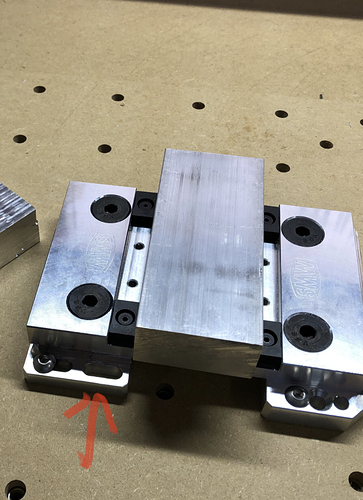This statement is true.
I guess if it was on a pivot that might be true, but the reactionary force opposite of the vise is equal, plus with stick out of the part, I’d be creating a larger lever arm if I moved the talons in on both sides.
Your screw is your pivot in this case. So as it’s clamped now you have least holding force. But you have too much space between your holes so you can’t move it closer as it is. Put in more threaded holes and it would be at least better than it’s now.
Sorry I’m really not tracking. I’ve got plenty of holes. The spacing of the holes isn’t an issue since the holes are just there to adjust the location of the vise and one is always fixed. The tension force of the vise is coming from the large eccentric black bolts. The issues is that the clamping force of the vise requires that the face of the face is in constant rigid contact with the bed, but the mdf + the threaded inserts flex so that movement is what is causing the talons to lose grip, even if the vise aren’t relocated from the fixture. Think of it like tectonic plates shifting up and down vertically, not laterally
Yes so if you could mount it at the red arrow it should get much more lateral stability. Now it’s like a big spring
None of your math and mechanical reasoning holds if the MDF is yielding underneath the vise (surfaced MDF is softer than the raw face), or the MDF itself is bowing ever so slightly, or if the vise is sliding, or if the threaded inserts are pushed laterally into the MDF on one side. When I really crank down on Luke’s gator tooth clamps, I can see just the tiniest bit of movement in the part, or the clamp, even though I’ve bolted down everything as tight as I dare. The Mod Vise is a really good clamping solution, but it’s only as good as the base it’s attached to.
Yes I can. And I did it both ways. It honestly didn’t change the issue with the table flex
Exactly the issue. Its not always obvious until you’ve got large chunks of Aluminum flying around.
large chunk of aluminum flys by
“somethings not right…” 
MDF is economical. It has predictable properties. It is not, on the other hand, steel. Or aluminum. Or oak.
It is a wet noodle structurally. Young’s modulus (coefficient of elasticity- this describes how much force/unit area is needed to bend, stretch, or compress the material) is about 3.6GPa, whereas pine is about 10GPa (grainway, less cross grain), oak is about 12GPa, and aluminum is about 70GPa —20 times stiffer. Steel is about 200GPa.
MDF flexes. Add to that the tendency to creep under load, laminar separation cross thickness (the same reason it splits when screws are driven into the edge and the inserts loosen or tear free over time), and so on, I would not expect good behavoiur in this application. A piece of aluminum fixture plate (jig plate) will do MUCH better.
Yep. But then again I was just testing other work holdings, the end result is its not useable directly with MDF, so added cost to add rigid subplate which I was going to do anyway. That’s the learning part
You don’t need to plate the whole machine.
If you work with the vise in one area, you might even be able to mount two aluminum bars UNDER the bed and thread the vise halves down to them through the existing holes, so the MDF is squeezed between. You would want to remove the inserts from the holes used to make clearance for the (longer) bolts, and would probably want to tap the holes in the bars. Maybe 38X19mm (1-1/2" by 3/4", nominal) edgewise is tremendously stiff for an application like this.
i also dabble in risky workholding behavior… 
This topic was automatically closed 30 days after the last reply. New replies are no longer allowed.
